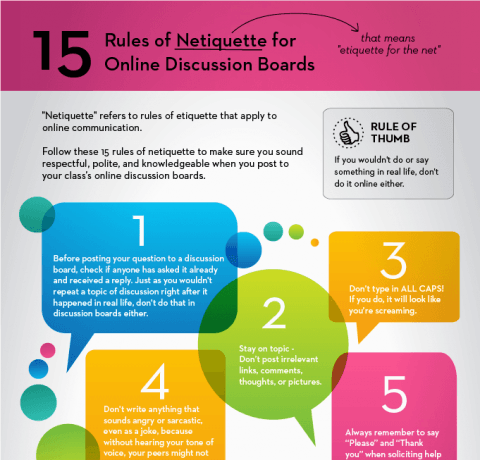- Club purchase that comes with rules of etiquette crossword clue
- 5 rules of golf etiquette
- The rules of etiquette in internet communications and postings are called
Rules of email etiquette
If you are forwarding an email message, use BCC (blind carbon copy) rather than CC (carbon copy) when sending it to more than one person. This helps protect the privacy of all the other email recipients https://angelesings.com/red-dog-casino/.
It is equally important to be mindful of who you decide to include, as some people prefer to not be added to large group texts or social media groups. Good netiquette involves getting their permission first to ensure that they’re okay with it.
There’s a time and a place for everything—BUT IN MOST SITUATIONS TYPING IN ALL CAPS IS INAPPROPRIATE. Most readers tend to perceive it as shouting and will have a hard time taking what you say seriously, no matter how intelligent your response may be. If you have vision issues, there are ways to adjust how text displays so you can still see without coming across as angry or upset.
Continue to make real people a priority while in public places such as restaurants, public transit, stores, elevators, and libraries. You can do this by not having phone conversations when in these shared spaces, as well as by silencing your audible notifications.

Club purchase that comes with rules of etiquette crossword clue
The answer to “Club purchase that comes with rules of etiquette” in the New York Times puzzle February 22, 2025 is LAPDANCE (Across 58). Quite straight and simple! Complete your daily NYT challenge with this solution.
We hope you found the right answer here. If this solution doesn’t solve the clue, or if you have another solution for the Club purchase that comes with rules of etiquette crossword clue, please email us with the source and date of publication. We will review it as soon as possible. Your help is greatly appreciated.
Club purchase that comes with rules of etiquette Crossword Clue Answers are listed below. Did you came up with a word that did not solve the clue? In case you did, worry not because we have the most recent and up-to-date answer for it. If you have seen the clue before, we encourage you try to remember the solution one more time before viewing the answer. All the clues are regularly checked and updated.
Christine Mielke has been an avid fan of word games and puzzles for over two decades. She loves to unscramble words, challenge herself to crossword puzzles and try out the latest word games. As a published author and database architect, it was natural for her to take her love for all things word games to the next level!
We found 40 solutions for Club purchase that comes with rules of etiquette. The top solutions are determined by popularity, ratings and frequency of searches. The most likely answer for the clue is LAPDANCE.
5 rules of golf etiquette
So you’ve made it to the first tee on the golf course. Where should you stand? The better question might be where shouldn’t you stand. Individual golfers have their own quirks and pet peeves, but generally you don’t want to be anywhere in front of the player teeing off or in the player’s line of vision. So directly across from the player (the same line as the ball) is probably not a good idea, and many players don’t like it when someone is directly behind them. The one exception to the latter might be when the golfer is teeing off into the sun, so you can help the player locate the ball after it’s hit. Also important: try not to move while the player is swinging, and no talking. And it doesn’t bother every golfer, but sitting in your golf cart while the others are hitting tee shots can be considered rude, too, so it’s always best to watch the other players shots and even encourage them.
This will drive serious golfers nuts. Don’t use the course as a driving range. So you hit a bad shot. As long as it’s findable or not out of bounds, don’t hit another one. It slows everybody down, and there’s nothing worse than having to look for two balls from one player when it’s totally unnecessary.
Ask the country club ahead of time about their rules on divots. Many golf courses offer a mixture of soil and grass seed that you can pour into the divot, which helps to restore the fairway to its original condition.
It is also a good idea to put ball marks on your ball and know the brands of your golf buddies. When you hit the ball out on the course, golf balls all look the same, creating an issue with mixing up the balls. If you have the same brand as a buddy, mark your ball to find it fast.

So you’ve made it to the first tee on the golf course. Where should you stand? The better question might be where shouldn’t you stand. Individual golfers have their own quirks and pet peeves, but generally you don’t want to be anywhere in front of the player teeing off or in the player’s line of vision. So directly across from the player (the same line as the ball) is probably not a good idea, and many players don’t like it when someone is directly behind them. The one exception to the latter might be when the golfer is teeing off into the sun, so you can help the player locate the ball after it’s hit. Also important: try not to move while the player is swinging, and no talking. And it doesn’t bother every golfer, but sitting in your golf cart while the others are hitting tee shots can be considered rude, too, so it’s always best to watch the other players shots and even encourage them.
This will drive serious golfers nuts. Don’t use the course as a driving range. So you hit a bad shot. As long as it’s findable or not out of bounds, don’t hit another one. It slows everybody down, and there’s nothing worse than having to look for two balls from one player when it’s totally unnecessary.
The rules of etiquette in internet communications and postings are called
When communicating electronically, whether through email, instant message, discussion post, text, or some other method, practice the Golden Rule: Do unto others as you would have others do unto you. Remember, your written words are read by real people, all deserving of respectful communication. Before you press “send” or “submit,” ask yourself, “Would I be okay with this if someone else had written it?”
What is meant by “flaming” and “flame wars?” “Flaming is what people do when they express a strongly held opinion without holding back any emotion.” (Shea, 1994). As an example, think of the kinds of passionate comments you might read on a sports blog. While “flaming” is not necessarily forbidden in virtual communication, “flame wars,” when two or three people exchange angry posts between one another, must be controlled or the camaraderie of the group could be compromised. Don’t feed the flames; extinguish them by guiding the discussion back to a more productive direction.
Amy Morin, LCSW, is a psychotherapist and international bestselling author. Her books, including “13 Things Mentally Strong People Don’t Do,” have been translated into more than 40 languages. Her TEDx talk, “The Secret of Becoming Mentally Strong,” is one of the most viewed talks of all time.
Boberg S, Schatto-Eckrodt T, Frischlich L, Quandt T. The moral gatekeeper? Moderation and deletion of user-generated content in a leading news forum. Media Commun. 2018;6(4). doi:10.17645/mac.v6i4.1493
Not everyone has the same amount of experience working in the virtual world. And not everyone knows the rules of netiquette. At some point, you will see a stupid question, read an unnecessarily long response, or encounter misspelled words; when this happens, practice kindness and forgiveness as you would hope someone would do if you had committed the same offense. If it’s a minor “offense,” you might want to let it slide. If you feel compelled to respond to a mistake, do so in a private email rather than a public forum.
